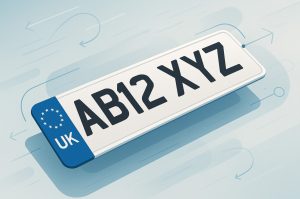Table of Contents
ToggleWhy does the DVLA revise number plate rules every October? The answer lies in the need for updated vehicle identification systems, improved road safety, and better enforcement tools. October is one of two periods each year when the DVLA reviews and implements regulatory updates, the other being March.
The changes set to take effect in October 2025 are not just minor tweaks. They reflect a shift toward more durable, visible, and regulation-compliant number plates that can be reliably read by both humans and automated systems such as ANPR (Automatic Number Plate Recognition). These updates are part of a broader strategy to keep the UK’s vehicle identification system secure and efficient, particularly as road technology evolves.
In addition to technical adjustments, October 2025 also marks a key date for motorists interested in purchasing new prefix-style number plates, with thousands being made available for direct sale by the DVLA.
What Specific Number Plate Rules Are Changing This October?

The October 2025 changes focus on improving number plate legibility, durability, and legal enforcement. Key changes relate to font consistency, character spacing, material standards, and visibility in poor lighting conditions.
All number plates must now comply with the BS AU 145e standard, which defines how plates should be constructed and displayed. This includes enhanced reflectivity for improved night-time visibility and restrictions on any modifications that affect legibility.
Decorative elements such as 3D effects, shadowing, or italic fonts are no longer allowed. Characters must be printed in the Charles Wright typeface, and spacing must match DVLA-specified measurements exactly. Non-compliant plates will fail MOT tests and may attract penalties.
When Will the New Prefix Number Plates Be Released by the DVLA?
On Tuesday 7th October 2025 at 10am, thousands of new prefix-style registration numbers will be released for public purchase directly via the DVLA’s official website. This release offers car owners, collectors, and businesses a chance to secure desirable or personalised plates before they are taken by others.
Prefix number plates, such as A123 XYZ, follow a format where the leading letter identifies the year of issue. These plates are popular for personalisation, branding, or simply owning a registration that reflects a name or message.
All new prefix registrations will start from £250, which includes VAT and the standard £80 assignment fee. Once purchased, a registration can be assigned immediately to a vehicle or held for future use.
This release typically sees a high volume of traffic, and registrations are sold on a first-come, first-served basis. Those looking for something specific are encouraged to act promptly once the release begins.
How Do These Changes Affect Personalised Registration Plates?

Motorists who currently own or are considering a private number plate must ensure it adheres to the updated rules. Personalised registrations remain legal, but how they are displayed is subject to stricter enforcement.
Plates must use the standard typeface and comply with spacing regulations. Any attempt to rearrange or stylise the characters to form words, names, or brands through incorrect spacing or design is now considered misrepresentation and is subject to penalties.
For example, a plate like S1 MON designed to resemble the name “Simon” would be illegal if spacing or character design was manipulated. Even if the registration is valid, if the physical plate on the vehicle doesn’t follow DVLA specifications, it can lead to fines and MOT failure.
Those purchasing new personalised plates in the October 2025 release should ensure they are produced by a DVLA-registered supplier, who will manufacture them according to the current legal standards.
What Are the Consequences of Not Following These New Plate Rules?
The consequences of non-compliance are becoming more severe, especially with the DVLA’s emphasis on automated enforcement and digital vehicle databases. If a number plate does not meet the October 2025 standards, the vehicle can fail its MOT inspection.
Beyond MOT issues, police or DVLA officers may issue on-the-spot fines of up to £1,000. Vehicles may also be marked as non-compliant in government databases, which could affect resale value or insurance coverage.
More importantly, plates that do not meet visibility or readability standards can be unreadable by ANPR systems, which may trigger alerts for unregistered or suspicious vehicles, even if the car is legally registered.
How Can Motorists Check If Their Number Plate Is Compliant?
Motorists can take a few simple steps to ensure their number plates meet the latest DVLA regulations.
The first is to visually inspect the plate for signs of wear, fading, cracking, or damage. Plates should be made of high-quality reflective material and must display the manufacturer’s name and BS AU 145e mark in the bottom corner.
Spacing and character size should be consistent with DVLA requirements. Measuring tools or online templates can be used to check spacing, and comparison with official examples is recommended.
For a more thorough check, motorists can visit the GOV.UK website and use available tools to confirm compliance or identify the nearest approved plate manufacturer.
What Is the Difference Between March and October DVLA Plate Updates?
The DVLA issues updates to number plates twice each year, in March and October, but each serves a different function.
| Update Month | Focus | Example |
| March | New registration codes | Release of “25” number plates |
| October | Regulatory compliance & releases | Enforcement of plate standards; prefix availability |
March updates typically introduce new vehicle identifiers to reflect the model year. October, on the other hand, focuses on changes to legal requirements, plate materials, and visibility enhancements. The October 2025 release is notable both for its regulatory tightening and for making thousands of new prefix registrations available to the public.
What Steps Should Car Owners Take to Comply With These Changes?

Owners should begin by reviewing the current condition and compliance of their existing number plates. If a plate is not reflective, uses incorrect spacing, or includes non-standard fonts, it should be replaced.
For those interested in acquiring a new plate, either for personal or professional use, the DVLA’s October release provides a timely opportunity. After purchasing a plate, it should be fitted by a certified supplier who can ensure the correct material and formatting are used.
Anyone planning to gift or assign a registration should also be aware of the assignment rules. A registration can be held on a retention certificate until needed, and can be transferred online through the DVLA’s vehicle registration portal.
What Should Fleets and Dealerships Do About the DVLA Changes?
For dealerships, fleet managers, and leasing firms, the October 2025 changes bring both challenges and opportunities. Ensuring that all vehicles comply with updated number plate rules is essential to avoid failed MOTs and potential fines.
Staff should be trained to inspect plates during vehicle intake or servicing. Vehicles being prepared for sale must be checked for compliance, especially if personalised plates are involved.
The October prefix release also provides businesses with the chance to acquire new plates that can be used for branding or vehicle identification. For example, a logistics company might secure registrations like L25 TRK for fleet branding.
What Will the October 2025 Prefix Registration Process Look Like?
The DVLA’s process for purchasing new prefix registrations is straightforward. Beginning at 10am on 7 October 2025, buyers can access the list of available plates on the DVLA website.
Each registration is sold at a starting price of £250, which includes VAT and the £80 assignment fee. Buyers can:
- Search for specific combinations using names, initials, or keywords
- Reserve and pay for the plate online
- Assign it to a vehicle immediately or hold it on a retention certificate for later
Purchases are processed through DVLA’s secure portal, and official documentation is issued within days.
How Do These Updates Fit Into the Broader Number Plate Regulations?
The DVLA’s updates in October 2025 reflect an ongoing commitment to standardising vehicle identification in the UK. By enforcing consistency in spacing, font, material, and construction, the DVLA aims to support technologies that rely on accurate number plate readings.
The use of compliant number plates is not just a legal requirement; it contributes to road safety and efficient policing. With the availability of new prefix registrations, there’s also an opportunity for personal or business expression, as long as the design adheres to the law.
FAQs About DVLA Number Plate Changes
Will I need to change my number plate even if it’s still readable?
Only if it doesn’t meet the new spacing, font, or reflectivity standards. Readability alone isn’t enough if it fails compliance checks.
Can I still personalise my number plate under the new rules?
Yes, but only within the display requirements set by the DVLA. Spacing or font manipulation is not permitted.
What is the cost of a new prefix plate?
Each new prefix registration starts at £250, inclusive of VAT and the £80 assignment fee.
Is the DVLA prefix registration release a one-time event?
Prefix plates are released in batches, and the 7 October release is one of the largest for 2025. Availability is first-come, first-served.
Will non-compliant plates cause an MOT failure?
Yes. MOT centres now check number plate compliance as part of their inspection process.
Are there specific plate suppliers I must use?
Yes. You must use DVLA-registered suppliers who produce plates according to BS AU 145e standards.
Can businesses benefit from the new plate release?
Absolutely. Prefix registrations can be useful for branding or easy vehicle identification within fleets.




